Chapter 07 Triangles
7.1 Introduction
You have studied about triangles and their various properties in your earlier classes. You know that a closed figure formed by three intersecting lines is called a triangle. (‘Tri’ means ’three’). A triangle has three sides, three angles and three vertices. For example, in triangle
7.2 Congruence of Triangles

Fig. 7.1
You must have observed that two copies of your photographs of the same size are identical. Similarly, two bangles of the same size, two ATM cards issued by the same bank are identical. You may recall that on placing a one rupee coin on another minted in the same year, they cover each other completely.
Do you remember what such figures are called? Indeed they are called congruent figures (‘congruent’ means equal in all respects or figures whose shapes and sizes are both the same).
Now, draw two circles of the same radius and place one on the other. What do you observe? They cover each other completely and we call them as congruent circles.
Repeat this activity by placing one square on the other with sides of the same measure (see Fig. 7.2) or by placing two equilateral triangles of equal sides on each other. You will observe that the squares are congruent to each other and so are the equilateral triangles.
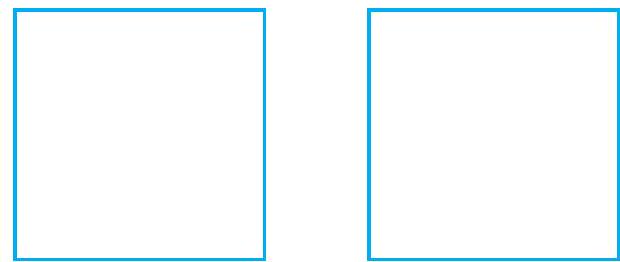
Fig. 7.2
You may wonder why we are studying congruence. You all must have seen the ice tray in your refrigerator. Observe that the moulds for making ice are all congruent. The cast used for moulding in the tray also has congruent depressions (may be all are rectangular or all circular or all triangular). So, whenever identical objects have to be produced, the concept of congruence is used in making the cast.
Sometimes, you may find it difficult to replace the refill in your pen by a new one and this is so when the new refill is not of the same size as the one you want to remove. Obviously, if the two refills are identical or congruent, the new refill fits.
So, you can find numerous examples where congruence of objects is applied in daily life situations.
Can you think of some more examples of congruent figures?
Now, which of the following figures are not congruent to the square in Fig 7.3 (i) :

Fig. 7.3
The large squares in Fig. 7.3 (ii) and (iii) are obviously not congruent to the one in Fig 7.3 (i), but the square in Fig 7.3 (iv) is congruent to the one given in Fig 7.3 (i).
Let us now discuss the congruence of two triangles.
You already know that two triangles are congruent if the sides and angles of one triangle are equal to the corresponding sides and angles of the other triangle.
Now, which of the triangles given below are congruent to triangle

Fig. 7.4
Cut out each of these triangles from Fig. 7.4 (ii) to (v) and turn them around and try to cover
If
Notice that when
That is,
Note that under this correspondence,
Similarly, for Fig. 7.4 (iii),
Give the correspondence between the triangle in Fig. 7.4 (iv) and
So, it is necessary to write the correspondence of vertices correctly for writing of congruence of triangles in symbolic form.
Note that in congruent triangles corresponding parts are equal and we write in short ’
7.3 Criteria for Congruence of Triangles
In earlier classes, you have learnt four criteria for congruence of triangles. Let us recall them.
Draw two triangles with one side

Fig. 7.5
Now, draw two triangles with one side

Fig. 7.6
See that these two triangles are not congruent.
Repeat this activity with some more pairs of triangles.
So, equality of one pair of sides or one pair of sides and one pair of angles is not sufficient to give us congruent triangles.
What would happen if the other pair of arms (sides) of the equal angles are also equal?
In Fig 7.7,
Recall from your earlier classes that, in this case, the two triangles are congruent. Verify this for

Fig. 7.7
This is the first criterion for congruence of triangles.
Axiom 7.1 (SAS congruence rule) : Two triangles are congruent if two sides and the included angle of one triangle are equal to the two sides and the included angle of the other triangle.
This result cannot be proved with the help of previously known results and so it is accepted true as an axiom (see Appendix 1).
Let us now take some examples.
Example 1 : In Fig. 7.8,
(i)
(ii)
Solution : (i) You may observe that in

Fig. 7.8
Also, since
So,
(ii) In congruent triangles
So,
Therefore,
Example 2 : AB is a line segment and line
Solution : Line
We have
So,
and so,

Fig. 7.9
Now, let us construct two triangles, whose sides are 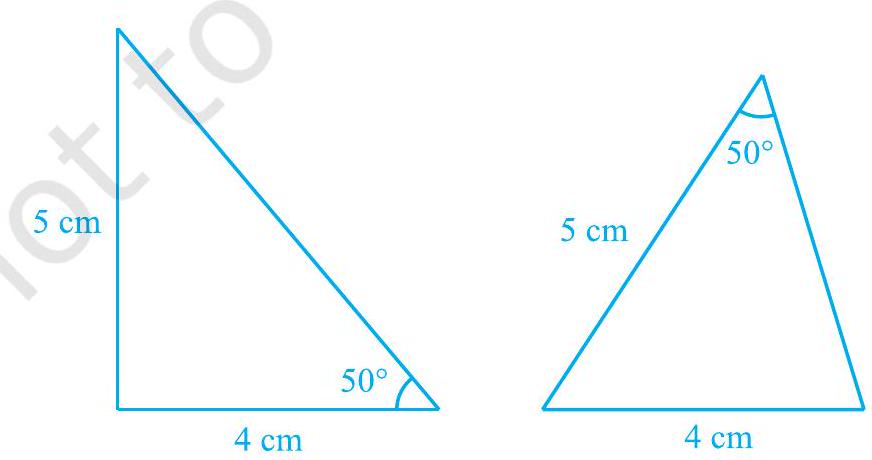
Fig. 7.10
Notice that the two triangles are not congruent.
Repeat this activity with more pairs of triangles. You will observe that for triangles to be congruent, it is very important that the equal angles are included between the pairs of equal sides.
So, SAS congruence rule holds but not ASS or SSA rule.
Next, try to construct the two triangles in which two angles are 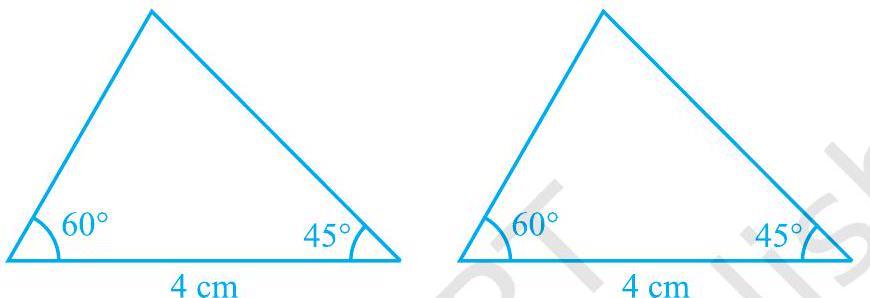
Fig. 7.11
Cut out these triangles and place one triangle on the other. What do you observe? See that one triangle covers the other completely; that is, the two triangles are congruent. Repeat this activity with more pairs of triangles. You will observe that equality of two angles and the included side is sufficient for congruence of triangles.
This result is the Angle-Side-Angle criterion for congruence and is written as ASA criterion. You have verified this criterion in earlier classes, but let us state and prove this result.
Since this result can be proved, it is called a theorem and to prove it, we use the SAS axiom for congruence.
Theorem 7.1 (ASA congruence rule) : Two triangles are congruent if two angles and the included side of one triangle are equal to two angles and the included side of other triangle.
Proof : We are given two triangles
and
We need to prove that
For proving the congruence of the two triangles see that three cases arise.
Case (i) : Let
Now what do you observe? You may observe that
So,
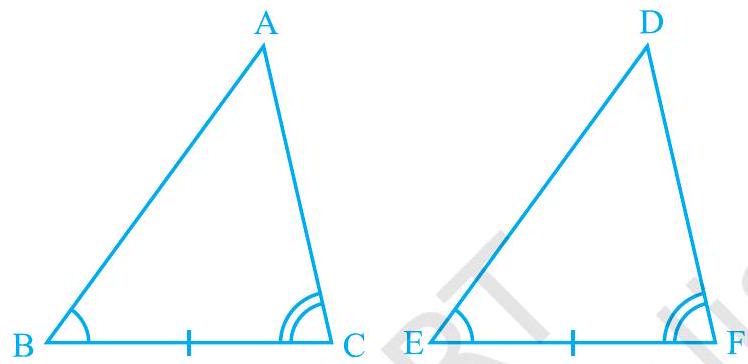
Fig. 7.12
Case (ii) : Let if possible 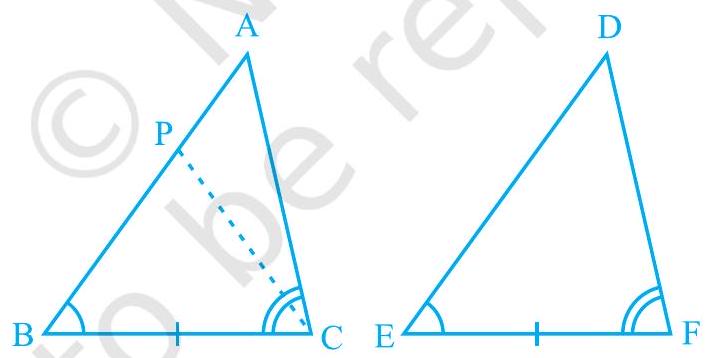
Fig. 7.13
Observe that in
So, we can conclude that:
Since the triangles are congruent, their corresponding parts will be equal.
So,
But, we are given that
Is this possible?
This is possible only if
or,
So,
Case (iii) : If
Suppose, now in two triangles two pairs of angles and one pair of corresponding sides are equal but the side is not included between the corresponding equal pairs of angles. Are the triangles still congruent? You will observe that they are congruent. Can you reason out why?
You know that the sum of the three angles of a triangle is
So, two triangles are congruent if any two pairs of angles and one pair of corresponding sides are equal. We may call it as the AAS Congruence Rule.
Now let us perform the following activity :
Draw triangles with angles
In fact, you can draw as many triangles as you want with different lengths of sides (see Fig. 7.14).

Fig. 7.14
Observe that the triangles may or may not be congruent to each other.
So, equality of three angles is not sufficient for congruence of triangles. Therefore, for congruence of triangles out of three equal parts, one has to be a side.
Let us now take some more examples.
Example 3 : Line-segment
Solution : (i) Consider

Fig. 7.15
Therefore,
(ii)
So,
EXERCISE 7.1
1. In quadrilateral
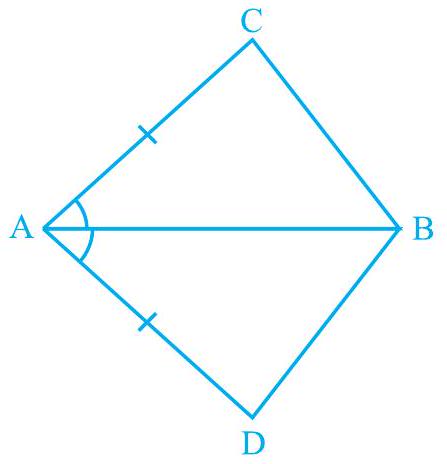
Fig. 7.16
Show Answer
Solution
In
Therefore, BC and BD are of equal lengths.
2.
(i)
(ii)
(iii)
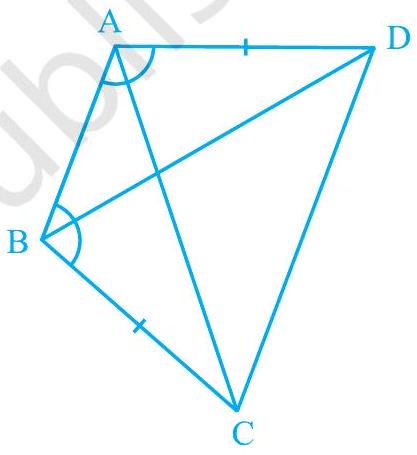
Show Answer
Solution
In
3.
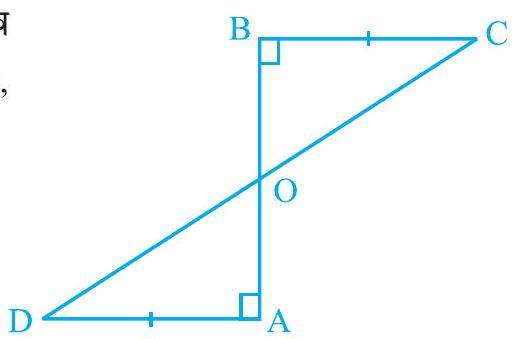
Show Answer
Solution
In
4.
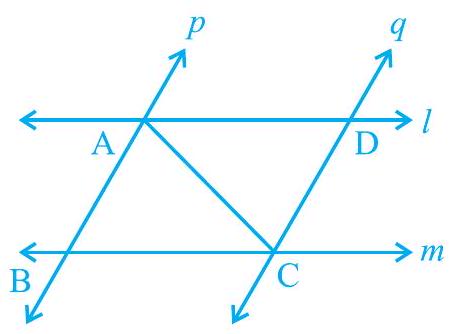
Fig. 7.19
Show Answer
Solution
In
5. Line
(i)
(ii)

Fig. 7.20
Show Answer
Solution
In
BQ (By CPCT)
rms of
6. In Fig. 7.21,

Fig. 7.21
Show Answer
Solution
It is given that
In
(Given)
7.
(i)
(ii)
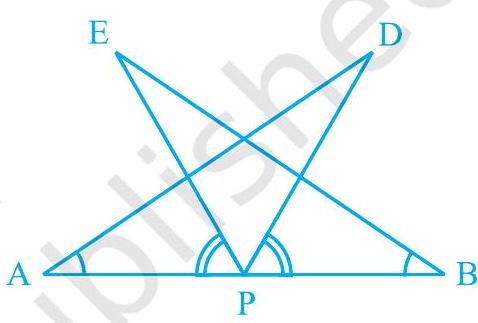
Fig. 7.22
Show Answer
Solution
It is given that EPA
In
8. In right triangle
(i)
(ii)
(iii)
(iv)
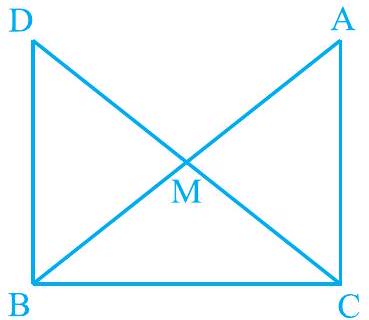
Fig. 7.23
Show Answer
Solution
(i) In
However, AेंCM and ¿BDM are alternate interior angles.
Since alternate angles are equal,
It can be said that
(iii) In
7.4 Some Properties of a Triangle
In the above section you have studied two criteria for congruence of triangles. Let us now apply these results to study some properties related to a triangle whose two sides are equal.
Perform the activity given below:
Construct a triangle in which two sides are equal, say each equal to

Fig. 7.24
Do you remember what is such a triangle called?
A triangle in which two sides are equal is called an isosceles triangle. So,
Now, measure
Repeat this activity with other isosceles triangles with different sides. You may observe that in each such triangle, the angles opposite to the equal sides are equal.
This is a very important result and is indeed true for any isosceles triangle. It can be proved as shown below.
Theorem 7.2 : Angles opposite to equal sides of an isosceles triangle are equal. This result can be proved in many ways. One of the proofs is given here.
Proof : We are given an isosceles triangle

Fig. 7.25
So,
So,
Is the converse also true? That is:
If two angles of any triangle are equal, can we conclude that the sides opposite to them are also equal?
Perform the following activity.
Construct a triangle

Fig. 7.26
Cut out the triangle from the sheet of paper and fold it along
What can you say about sides
Observe that
So,
Repeat this activity with some more triangles. Each time you will observe that the sides opposite to equal angles are equal. So we have the following:
Theorem 7.3 : The sides opposite to equal angles of a triangle are equal.
This is the converse of Theorem 7.2.
You can prove this theorem by ASA congruence rule. Let us take some examples to apply these results.
Example 4 : In

Fig. 7.27
Solution : In
So,
Example 5:

Fig. 7.28
Solution : In
Example 6 : In an isosceles triangle

Fig. 7.29
Solution : In
Also,
So,
That is,
So,
This gives
EXERCISE 7.2
1. In an isosceles triangle
(i)
(ii)
Show Answer
Solution

(i) It is given that in triangle
(ii) In
Therefore,
2. In
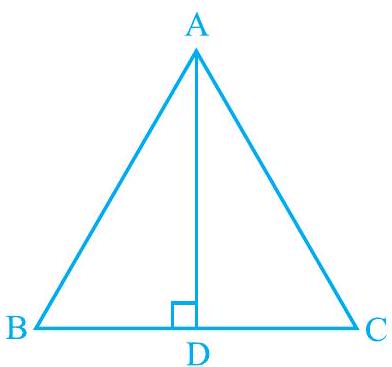
Fig. 7.30
Show Answer
Solution
In
Therefore,
3.
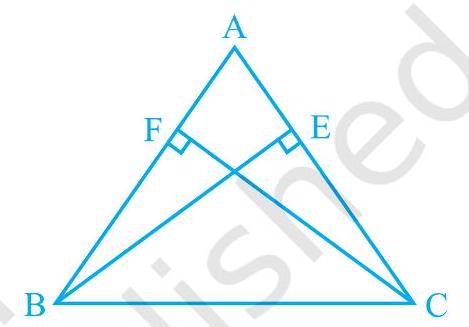
Fig. 7.32
Show Answer
Solution
In
4.
(i)
(ii)
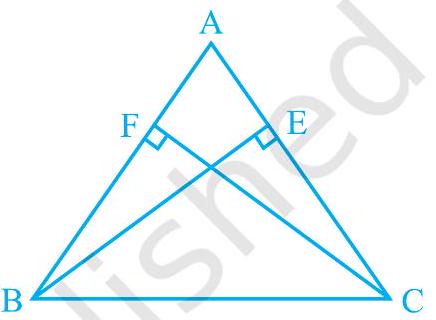
Fig. 7.32
Show Answer
Solution
(i) In
(ii) It has already been proved that
5.
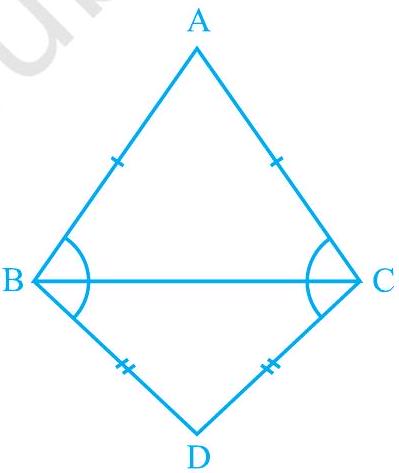
Fig. 7.33
Show Answer
Solution
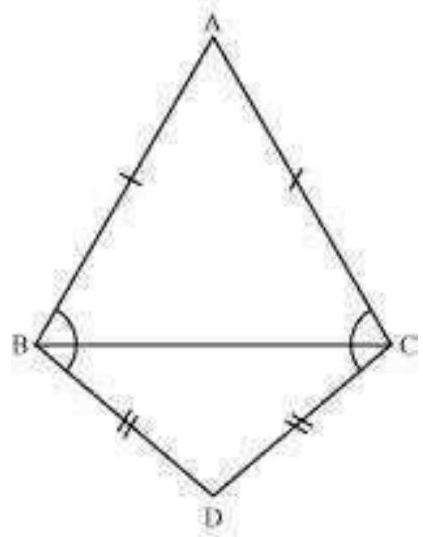
Let us join
In
6.
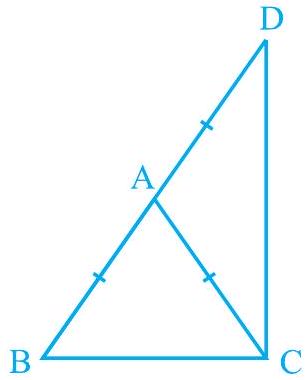
Fig. 7.34
Show Answer
Solution
In
In
In
7.
Show Answer
Solution
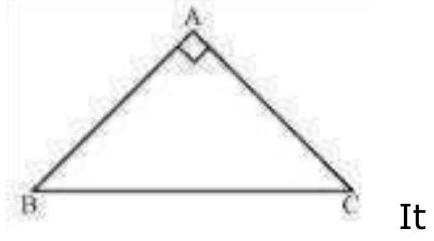
It is given that
In
8. Show that the angles of an equilateral triangle are
Show Answer
Solution
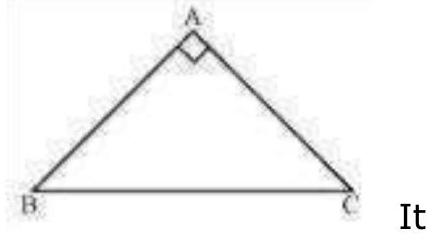
Let us consider that
Therefore,
Also,
Therefore, we obtain
In
7.5 Some More Criteria for Congruence of Triangles
You have seen earlier in this chapter that equality of three angles of one triangle to three angles of the other is not sufficient for the congruence of the two triangles. You may wonder whether equality of three sides of one triangle to three sides of another triangle is enough for congruence of the two triangles. You have already verified in earlier classes that this is indeed true.
To be sure, construct two triangles with sides 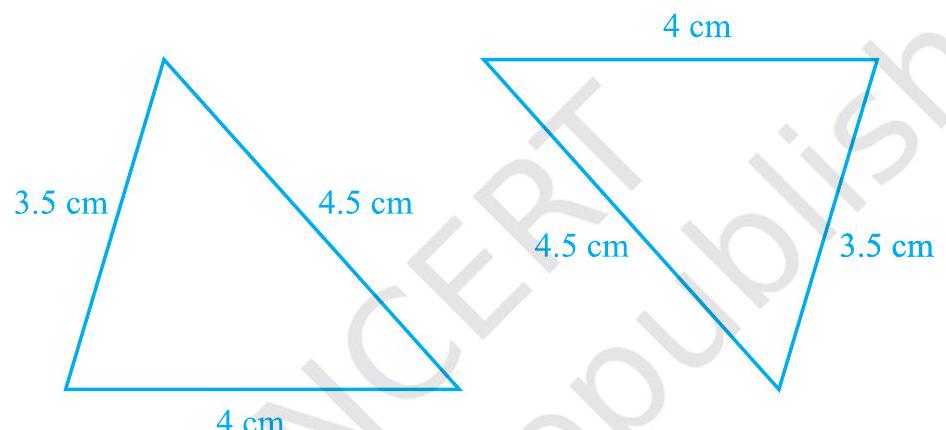
Fig. 7.35
Repeat this activity with some more triangles. We arrive at another rule for congruence.
Theorem 7.4 (SSS congruence rule) : If three sides of one triangle are equal to the three sides of another triangle, then the two triangles are congruent.
This theorem can be proved using a suitable construction.
You have already seen that in the SAS congruence rule, the pair of equal angles has to be the included angle between the pairs of corresponding pair of equal sides and if this is not so, the two triangles may not be congruent.
Perform this activity:
Construct two right angled triangles with hypotenuse equal to

Fig. 7.36
Cut them out and place one triangle over the other with equal side placed on each other. Turn the triangles, if necessary. What do you observe?
The two triangles cover each other completely and so they are congruent. Repeat this activity with other pairs of right triangles. What do you observe?
You will find that two right triangles are congruent if one pair of sides and the hypotenuse are equal. You have verified this in earlier classes. Note that, the right angle is not the included angle in this case.
So, you arrive at the following congruence rule:
Theorem 7.5 (RHS congruence rule) : If in two right triangles the hypotenuse and one side of one triangle are equal to the hypotenuse and one side of the other triangle, then the two triangles are congruent.
Note that RHS stands for Right angle - Hypotenuse - Side.
Let us now take some examples.
Example 7 :
Solution : You are given that

Fig. 7.37
In these triangles,
So,
Therefore,
Now let us consider
So,
Therefore,
and
From (1) and (2), you can easily conclude that PQ is the perpendicular bisector of AB.
[Note that, without showing the congruence of
and
It is because these results give us SSA rule which is not always valid or true for congruence of triangles. Also the angle is not included between the equal pairs of sides.]
Let us take some more examples.
Example 8 :
Solution : You are given that lines
You are to show that
Let us consider

Fig. 7.38
So,
So,
Note that this result is the converse of the result proved in Q. 5 of Exercise 7.1.
EXERCISE 7.3
1.
(i)
(ii)
(iii) AP bisects
(iv)
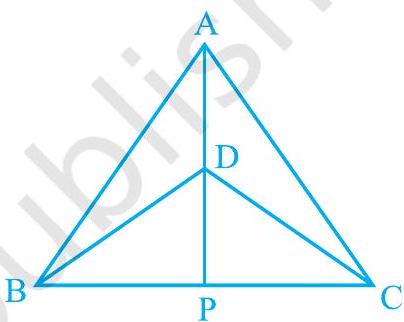
Fig. 7.39
Show Answer
Solution
(i) In
(ii) In
(iii) Since
So,
i.e. AP bisects
In
DP
So, AP bisects
From (iii) and (iv),
AP bisects
(iv) We know that
Also,
Hence,
2.
(i)
(ii)
Show Answer
Solution
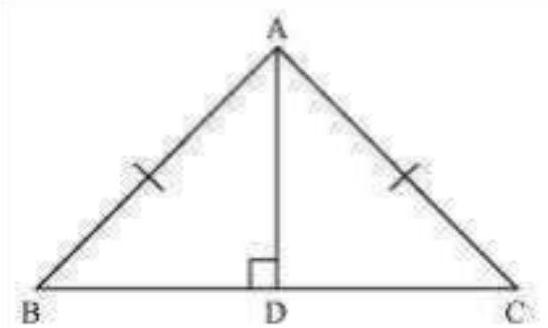
(i) In
Hence,
(ii) Also, by CPCT,
bisects A. :
3. Two sides
(i)
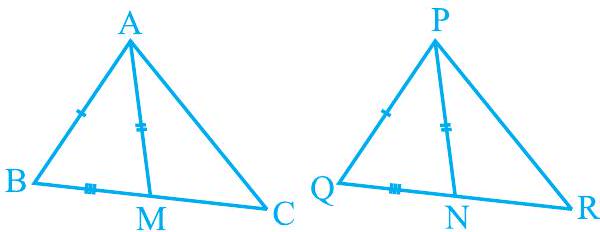
(ii)
Fig. 7.40
Show Answer
Solution
(i) In
However,
In
(ii) In
4.
Show Answer
Solution
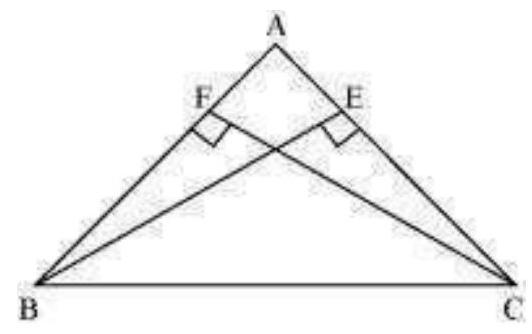
In
Hence,
5.
Show Answer
Solution
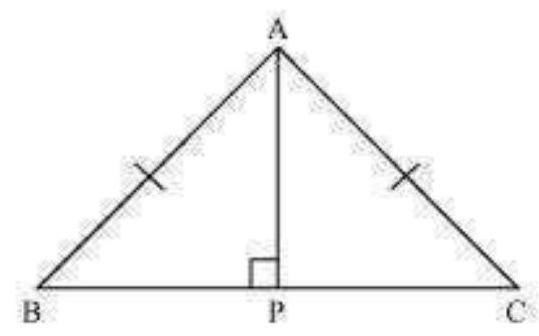
In
7.6 Summary
In this chapter, you have studied the following points :
1. Two figures are congruent, if they are of the same shape and of the same size.
2. Two circles of the same radii are congruent.
3. Two squares of the same sides are congruent.
4. If two triangles
5. If two sides and the included angle of one triangle are equal to two sides and the included angle of the other triangle, then the two triangles are congruent (SAS Congruence Rule).
6. If two angles and the included side of one triangle are equal to two angles and the included side of the other triangle, then the two triangles are congruent (ASA Congruence Rule).
7. If two angles and one side of one triangle are equal to two angles and the corresponding side of the other triangle, then the two triangles are congruent (AAS Congruence Rule).
8. Angles opposite to equal sides of a triangle are equal.
9. Sides opposite to equal angles of a triangle are equal.
10. Each angle of an equilateral triangle is of
11. If three sides of one triangle are equal to three sides of the other triangle, then the two triangles are congruent (SSS Congruence Rule).
12. If in two right triangles, hypotenuse and one side of a triangle are equal to the hypotenuse and one side of other triangle, then the two triangles are congruent (RHS Congruence Rule).










